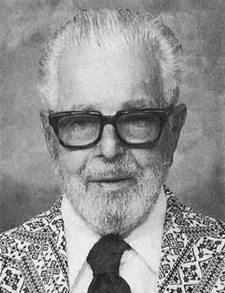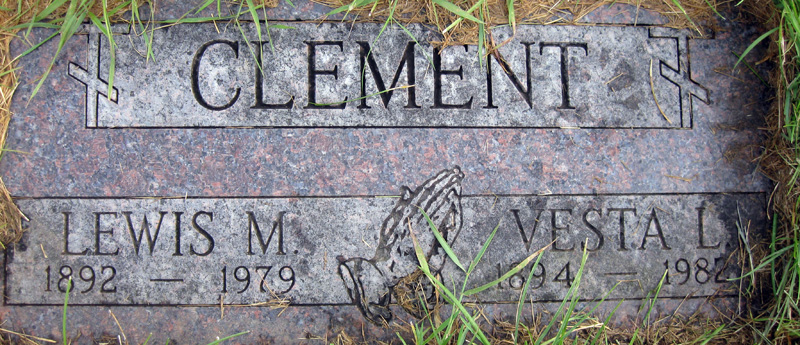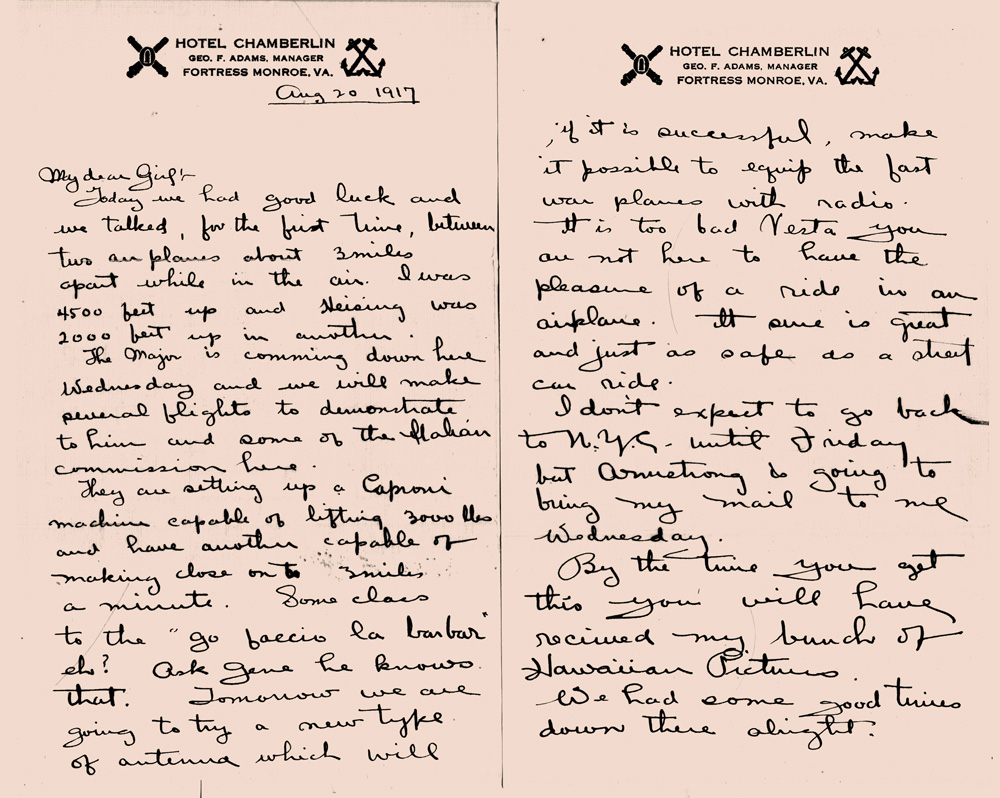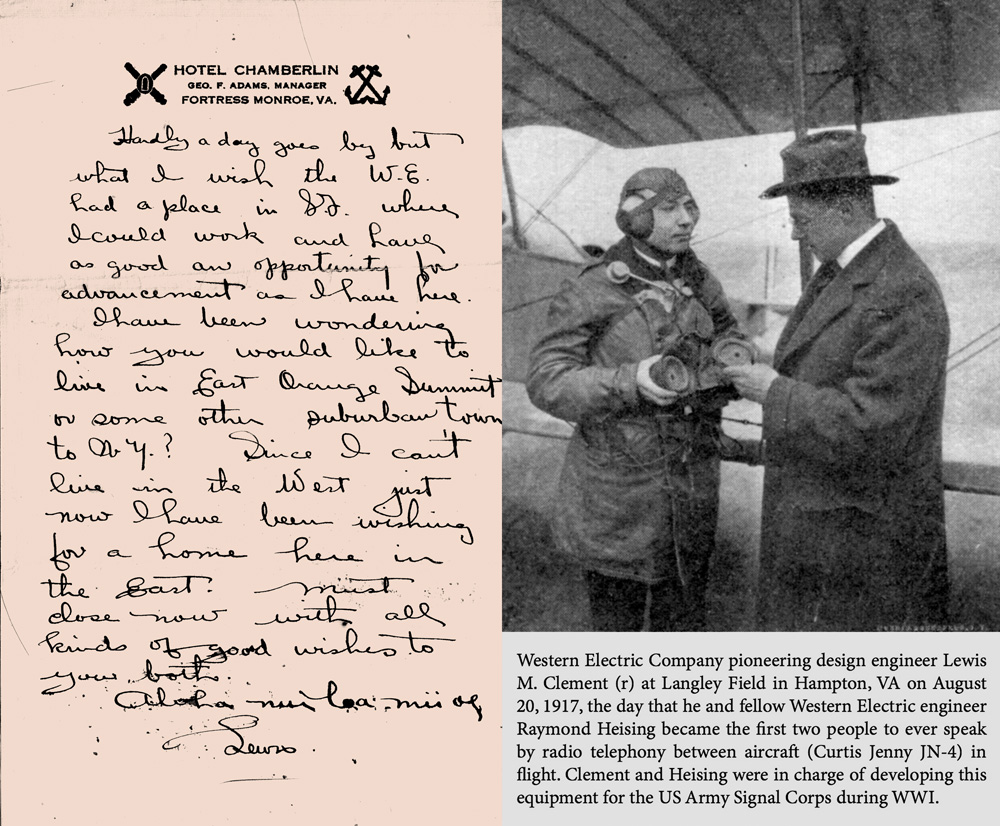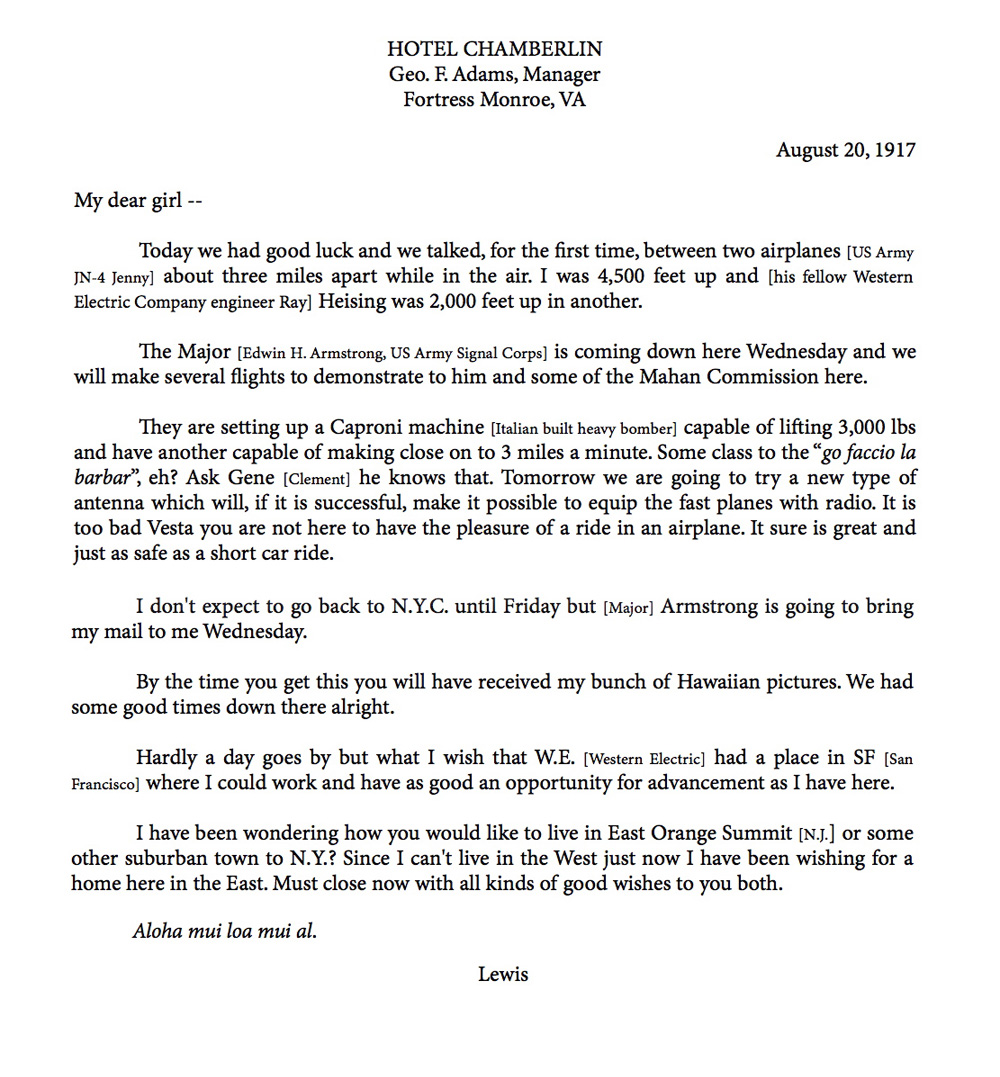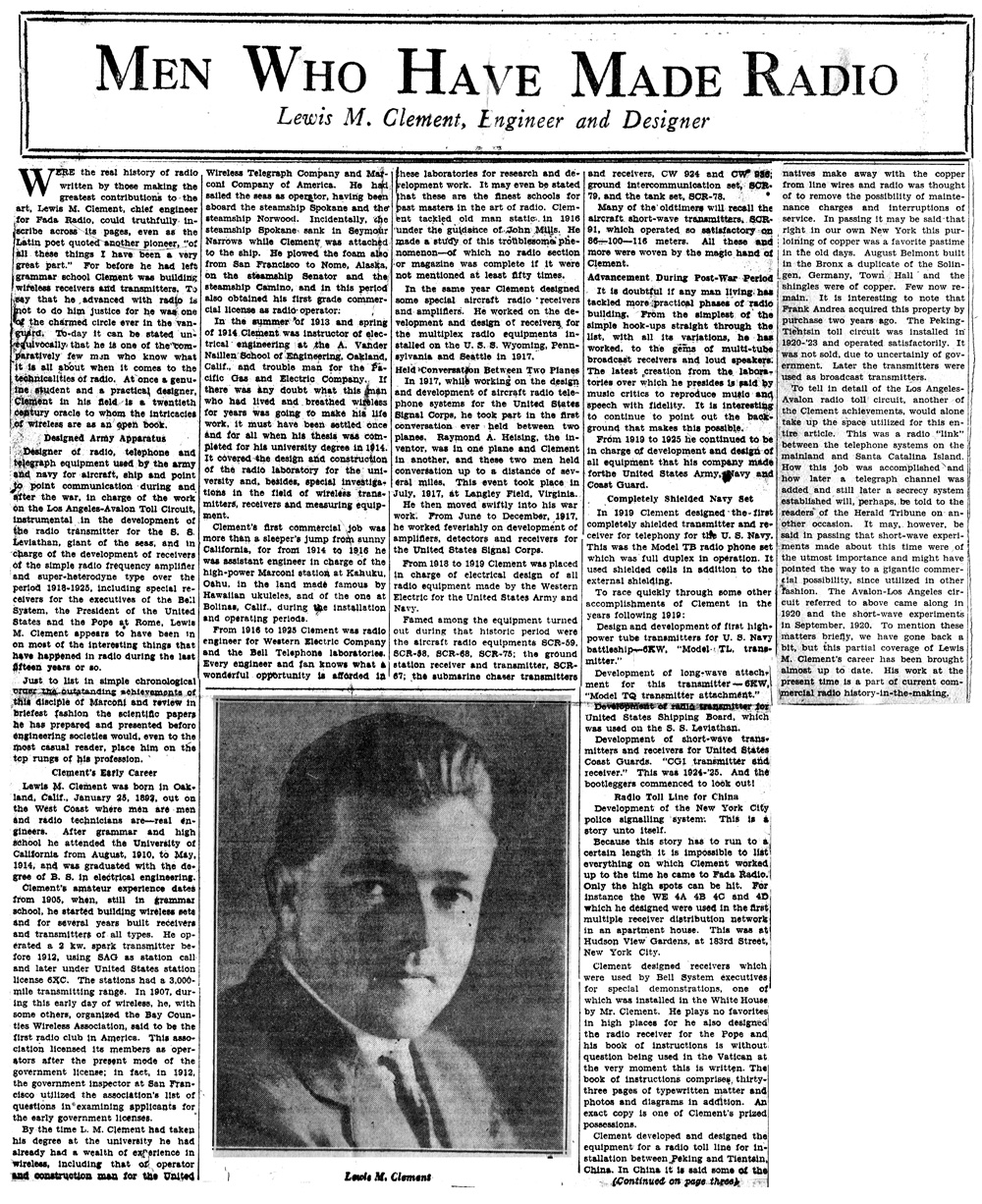He had common roots with two other God's gentlemen who also had a deep reverence for the Golden Rule and the Ten Commandments as a chosen way of life. Edwin Howard Armstrong of the east and Columbia University and The Radio Club was one; the other was Haraden Pratt, a classmate at the University of California at Berkeley, a State University that gave excellent instruction without any tuition fees whatever.
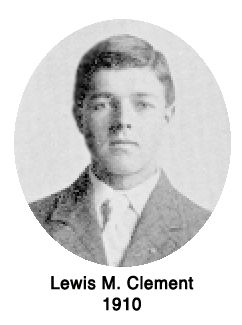 Clement was born in Oakland, California
on Jan. 25, 1892 and like Pratt, had his heart set upon electrical
engineering by the time he reached the university. During his
pre-university years, he was greatly influenced by his New Hampshire
native maternal grandfather, Capt. Eugene Freeman, a former Cape Horn
and China Clipper ship captain, pioneer, and later Port Commissioner of
San Francisco. Not only did young Lewis obtain a love for navigation
then, but he also had impressed upon him that a sea captain in the
earlier days was a very lonely man indeed when he was out of sight of
land, because he was out of communication with home for a long period
of time, and what little he might know of where he was at any time
could only be learned by star recognition. The sextant was a captain's
best friend. But a star in a sextant looks cold; it was not as warming
to the heart as a message from home.
Clement was born in Oakland, California
on Jan. 25, 1892 and like Pratt, had his heart set upon electrical
engineering by the time he reached the university. During his
pre-university years, he was greatly influenced by his New Hampshire
native maternal grandfather, Capt. Eugene Freeman, a former Cape Horn
and China Clipper ship captain, pioneer, and later Port Commissioner of
San Francisco. Not only did young Lewis obtain a love for navigation
then, but he also had impressed upon him that a sea captain in the
earlier days was a very lonely man indeed when he was out of sight of
land, because he was out of communication with home for a long period
of time, and what little he might know of where he was at any time
could only be learned by star recognition. The sextant was a captain's
best friend. But a star in a sextant looks cold; it was not as warming
to the heart as a message from home.His Canadian-born paternal grandfather, Lewis Metzler Clement, was also a trnsportation pioneer of the West. A civil engineer who had worked on the Welland Canal in Canada and later on the Ohio & Mississippi Railroad in St. Louis, MO, in 1862 the elder Clement emigrated to California taking 149 days to reach Sacramento by wagon train where he was hired on by Theodore D. Judah, the Chief Engineer of the nascent Central Pacific Railroad of California which was soon to start building the western portion of the first transcontinental railroad. Between 1862 and 1869 Clement did much of the original surveying then supervised the construction of the CPRR grade over the Sierras and on to Nevada and Utah. He soon rose to being the CPRR’s Chief Assistant Engineer as well as Superintendent of Track until leaving the CPRR in 1881 to become Chief Engineer of the Pacific Improvement Company in San Francisco where he helped design that city’s cable car system. The senior Clement also helped Sen. Leland Stanford, his longtime employer with both the CPRR and PIC, to set up the Engineering Department at Stanford University. His son Russell, the younger Lewis Clement’s father, was also a civil engineer and a graduate of MIT who went on to be the City Engineer of Oakland.
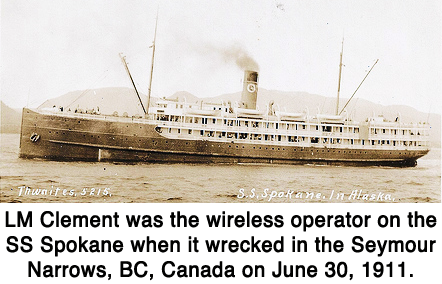 With
this family engineering
background, it is hardly strange, then, that he was tacitly encouraged
to become interested in wireless. At age 13 Clement built and operated
his first radio station (call letters 6XC) from his home in Oakland in
1905, was Co-Founder and Secretary of the Bay Counties Wireless
Telegraph Association in 1907, and in 1908 he made the first ever
broadcast of a sporting event, the University of California vs Stanford
football game. He soon learned how to tap the key of his rotary
gap outfit without putting out the lights in the Clements’
one-family house along with the lights of several neighbors as well as
had been the case earlier. His
classmates such as Haraden Pratt learned the same too, even before they
started their studies of electrical engineering. All three became the outstanding leaders at
the front of a very rapidly moving, changing and progressive art that
has led today to virtually instantaneous round-the-world communication
as well as communication with real men on the Moon and radio space
probes that bid fair to reach the very limits of the universe. He was in good
company; each admired the work of the others, concentrating upon what
he felt he could do best and admiring what each of the other men did
that was superb and unique. Clement
bcame a radio profssional or the first time when took a summer job
while a 19-year old college student as the wireless operator on the Pacific Coast Steamship Company coastal passenger steamer S.S.
Spokane remaining on board
with the captain when it struck a rock in Seymour Narrows, British
Columbia, Canada, on June 30, 1911 and was then beached in Plumper Bay
near Esquimalt to avoid sinking in deep water.
With
this family engineering
background, it is hardly strange, then, that he was tacitly encouraged
to become interested in wireless. At age 13 Clement built and operated
his first radio station (call letters 6XC) from his home in Oakland in
1905, was Co-Founder and Secretary of the Bay Counties Wireless
Telegraph Association in 1907, and in 1908 he made the first ever
broadcast of a sporting event, the University of California vs Stanford
football game. He soon learned how to tap the key of his rotary
gap outfit without putting out the lights in the Clements’
one-family house along with the lights of several neighbors as well as
had been the case earlier. His
classmates such as Haraden Pratt learned the same too, even before they
started their studies of electrical engineering. All three became the outstanding leaders at
the front of a very rapidly moving, changing and progressive art that
has led today to virtually instantaneous round-the-world communication
as well as communication with real men on the Moon and radio space
probes that bid fair to reach the very limits of the universe. He was in good
company; each admired the work of the others, concentrating upon what
he felt he could do best and admiring what each of the other men did
that was superb and unique. Clement
bcame a radio profssional or the first time when took a summer job
while a 19-year old college student as the wireless operator on the Pacific Coast Steamship Company coastal passenger steamer S.S.
Spokane remaining on board
with the captain when it struck a rock in Seymour Narrows, British
Columbia, Canada, on June 30, 1911 and was then beached in Plumper Bay
near Esquimalt to avoid sinking in deep water.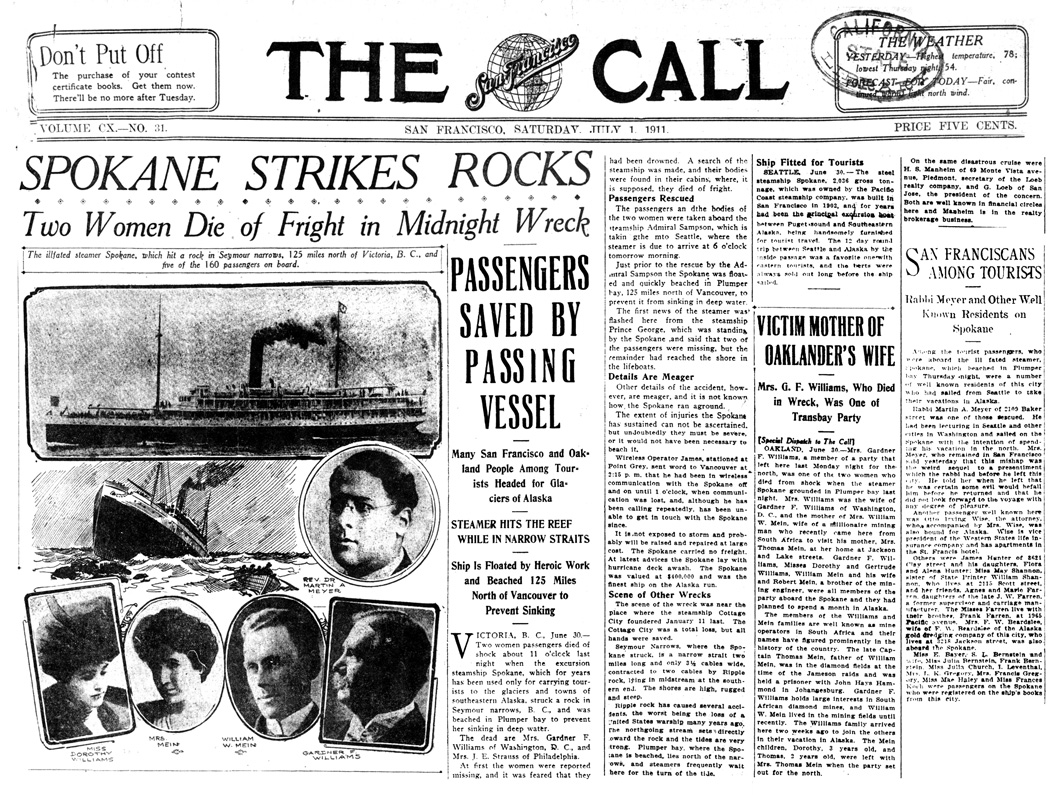
Story of the wreck of the S.S. Spokane in the San Francisco Call, July 1, 1911 (Click on above image to see larger version)
While an Electrical Engineering student at the University of California at Berkeley he was responsible for the engineering of the very first radio broadcast of a sporting event -- the 1912 "Big Game" between Berkeley and Stanford. After graduating from Cal in 1914, Clement spent two years with the Marconi Wireless Telegraph Company as both a radio operator and engineer for installation and operation. While running the Marconi station in Kahuku, Hawaii he found that the detector that Marconi furnished was both poor and unreliable, so he "sneaked in" a detector that would work, rather than the Marconi detector that didn't—especially, it seemed, when the operator at the distant transmitter had much traffic "to get off the hook". Fortunately Marconi inspection (to assure the use of only Marconi apparatus) was virtually non-existent; Pratt and Clement would have felt frustrated beyond human limits, had they been compelled to remove their "bootleg" substitutes. At that early stage both Clement and Pratt sought reliability of the highest sort to satisfy their inner drive to "make things work consistently at the highest level over the longest period of time".
 In
1916 Clement moved over to the
Western Electric Company as Engineer in charge of electrical design for
the radio communication equipment of Army and Navy. At Western Electric
he found a situation quite the opposite of that in Marconi; the
telephone industry sought excellence and reliability on a
24-hour-per-day, 7-day-per-week schedule and had already begun
manufacturing devices such as line finders that sought to operate
reliably for one million operations without failure. Western Electric
manufacturing was outstanding for built-in quality and its
manufacturing methods had already stabilized to the point where a
handset, bellbox, line finder, and central station equipment could be
installed just anywhere in the USA and work day in and day out in the
extreme moisture of the Mississippi delta region or 40-degree
temperatures in Montana for example, without failure due to either
corrosion or electrical leakage due to poor insulation. On August 18,
1917
he also became the first person to ever talk by voice from an airplane
to the ground while testing airborne transmitter and receivers at
Langley Field, VA that he had designed for use by the U.S. Army Air
Corps and two days later did the same with another airplane in flight
(see his August 20 letter to his then finacée, Vesta Lynde, below),
and in 1920 he developed and installed the first commercial
radiotelephone circuit between San Pedro, CA, and Avalon on Catalina
Island. In 1922 he developed the first Super Hetradyne receiver.
In
1916 Clement moved over to the
Western Electric Company as Engineer in charge of electrical design for
the radio communication equipment of Army and Navy. At Western Electric
he found a situation quite the opposite of that in Marconi; the
telephone industry sought excellence and reliability on a
24-hour-per-day, 7-day-per-week schedule and had already begun
manufacturing devices such as line finders that sought to operate
reliably for one million operations without failure. Western Electric
manufacturing was outstanding for built-in quality and its
manufacturing methods had already stabilized to the point where a
handset, bellbox, line finder, and central station equipment could be
installed just anywhere in the USA and work day in and day out in the
extreme moisture of the Mississippi delta region or 40-degree
temperatures in Montana for example, without failure due to either
corrosion or electrical leakage due to poor insulation. On August 18,
1917
he also became the first person to ever talk by voice from an airplane
to the ground while testing airborne transmitter and receivers at
Langley Field, VA that he had designed for use by the U.S. Army Air
Corps and two days later did the same with another airplane in flight
(see his August 20 letter to his then finacée, Vesta Lynde, below),
and in 1920 he developed and installed the first commercial
radiotelephone circuit between San Pedro, CA, and Avalon on Catalina
Island. In 1922 he developed the first Super Hetradyne receiver.By 1918 the 26-year old Clement was in charge of design and development of radio receivers and transmitters—and making certain that the prototypes worked as they should and that subsequent units work equally well. In 1925, Clement left Western Electric Research and Development (later called Bell Laboratories) for a three-year stint with F.A.D. Andrea as Chief Engineer for broadcast radio receivers. His 17 US patents include 1,353,145—Device for Varying Electrical Coupling (issue 1920), 1,395,390—Oscillation Generating system; 1,415,992—Receiving Station; 1,443,007—Control of Electric Circuits—1,590,346 Radio Direction Finding, all fundamental in a manner to meet the oath requirement of a US Patent of a "full, clear and exact description that will enable one skilled in the art to which it pertains to make and use the same;—and that he is the first to so disclose such.
From 1928 to 1930 he was at Kolster Radio (broadcast receivers) as V-P and Chief Engineer; then at Westinghouse as Assistant to the Manager of the Radio Department to 1931; then the Federal Telegraph-ITT and International Standard Electric as European Chief Engineer from 1932 to 1935. Each year he would return to the US, brief interested companies and their engineers on what the European companies were doing—and take back with him to Europe much that he learned that would be useful there. He was proud of this activity and loved it.
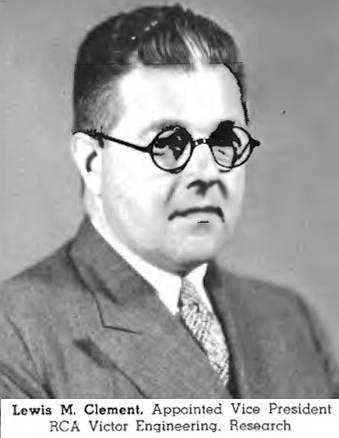 In about 1935, he had a phone call from
E. T. Cunningham, President of the Radio Corporation of America (RCA)
Manufacturing Company, asking him to lunch. Cunningham was under the
impression that Clement was looking for a new job—and he was not.
RCA-Camden was providing Cunningham with a prize
headache:—he was unable to obtain reliable information of
what the company was doing because of internecine squabbles and knowing
Clement "from the early days", wanted him as Vice President
in charge of Research and Engineering. But something stood in the way:
RCA Chairman David Sarnoff had an understanding with IT&T’s
founder Sosthenes Behn that neither would "raid" the other's
engineering staff. And generally speaking, such agreements
stuck—even if the engineers concerned were "stuck" with the
result. Neither Clement nor Cunningham considered this to be more
important than that the Company get the best man for the job—and
that such a good man should not be hog-tied against his will. Something
was worked out to clear up the dilemma and Clement joined RCA Camden in
1935 and stayed until 1940.
In about 1935, he had a phone call from
E. T. Cunningham, President of the Radio Corporation of America (RCA)
Manufacturing Company, asking him to lunch. Cunningham was under the
impression that Clement was looking for a new job—and he was not.
RCA-Camden was providing Cunningham with a prize
headache:—he was unable to obtain reliable information of
what the company was doing because of internecine squabbles and knowing
Clement "from the early days", wanted him as Vice President
in charge of Research and Engineering. But something stood in the way:
RCA Chairman David Sarnoff had an understanding with IT&T’s
founder Sosthenes Behn that neither would "raid" the other's
engineering staff. And generally speaking, such agreements
stuck—even if the engineers concerned were "stuck" with the
result. Neither Clement nor Cunningham considered this to be more
important than that the Company get the best man for the job—and
that such a good man should not be hog-tied against his will. Something
was worked out to clear up the dilemma and Clement joined RCA Camden in
1935 and stayed until 1940.In RCA he found the communications between different portions of the company virtually paralyzed: he started The Scanner, a House organ that told what was being done in engineering so that everyone in other parts of the company could know, and full communication be restored internally. Briefings from one branch to another cleared up most of the problems—and the "little kingdoms" within the company melted away. Truth, crushed to earth, did rise again. With superb results: quick deliveries on 50-KW transmitters, with top quality and with much improved broadcast sets—and everything else. Under Clement’s leadership RCA became something of another Bell Labs in its day-to-day operations. People communicated with one another!
 In 1940 he moved from RCA to Crosley in
Cincinnati as Vice-President of Research Development and Engineering,
where he also pulled that organization together just in time to start
as the First Prime Contractor for the VT Proximity Fuze for the Navy
Bureau of Ordnance. On October 28, 1941, Dr. L. R. Hafstad of Section
T, Office of Scientific Research and Development, representing the US
Navy Bureau of Ordnance, visited Crosley and asked to see the Chief
Engineer; he was accompanied by a BuOrd man from the local Ordnance
District. Since it was apparent that the US would enter WW2 with the
Allies, the Crosley organization had been streamlined—stripped
for action—and was ready. Dr. Hafstad and party, met with the
engineers, the facilities and qualifications of Crosley as Prime
Contractor were examined—and Crosley was approved for the VT
Proximity Fuze by verbal agreement on the same day. "Crosley is our
kind of people." They were soon Íembarked as the first
production manufacturers of the first "smart" ordnance fuze in world
history—the fuze that "knows when to go off"—it is
triggered by the presence of the target itself.
In 1940 he moved from RCA to Crosley in
Cincinnati as Vice-President of Research Development and Engineering,
where he also pulled that organization together just in time to start
as the First Prime Contractor for the VT Proximity Fuze for the Navy
Bureau of Ordnance. On October 28, 1941, Dr. L. R. Hafstad of Section
T, Office of Scientific Research and Development, representing the US
Navy Bureau of Ordnance, visited Crosley and asked to see the Chief
Engineer; he was accompanied by a BuOrd man from the local Ordnance
District. Since it was apparent that the US would enter WW2 with the
Allies, the Crosley organization had been streamlined—stripped
for action—and was ready. Dr. Hafstad and party, met with the
engineers, the facilities and qualifications of Crosley as Prime
Contractor were examined—and Crosley was approved for the VT
Proximity Fuze by verbal agreement on the same day. "Crosley is our
kind of people." They were soon Íembarked as the first
production manufacturers of the first "smart" ordnance fuze in world
history—the fuze that "knows when to go off"—it is
triggered by the presence of the target itself. On November 17, 1978 Lewis Mason Clement, together with all the proximity fuze pioneers available, met at the Sheraton Hotel, New York City, for a tape recording session—A Historical Review "I WAS THERE"—of the history through which all concerned had lived. The binaural tape was transcribed through Jerry Minter of the Radio Club with an assist from Harold Schwede, another club member, and a further assist from your humble servant, Bill Offenhauser. The entire text was edited by the Navy Historical Center in Washington. In the evening of the same day, many of those present in the afternoon recording session were at the Clement table at the Radio Club Annual Dinner when The Club awarded Lewis Mason Clement its Pioneer Award, and soon afterward. Admiral Gravely of the Defense Communications Agency, gave the dinner address.
Lewis Mason Clement was an extraordinary man, as modest as he was brilliant and ingenious. His concept of how to do things was so clear that he was able to cut the time between the start of a project and delivery of the first approved end result to a small fraction of what others did. And with the best end-result in addition. Well done, thou good and faithful servant, Lewis Mason Clement. The Radio Club of America and many many others salute you in Valhalla for your dedication to truth and to your service of your fellow man. None of your hard work was in vain; it has left an indelible chapter in the growth of that good Nation of ours that cannot be overlooked, since its fruits today are everywhere in the world.
